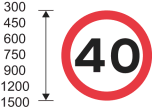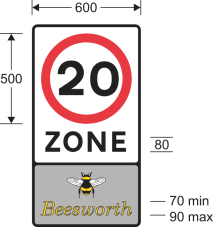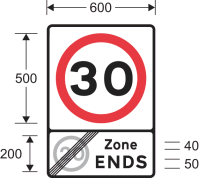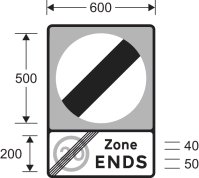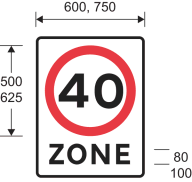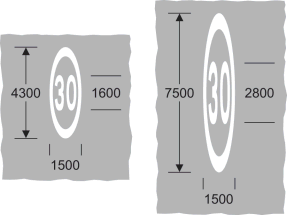- Latest available (Revised)
- Original (As made)
The Traffic Signs Regulations and General Directions 2016
You are here:
- UK Statutory Instruments
- 2016 No. 362
- SCHEDULE 10
More Resources
Status:
This is the original version (as it was originally made). This item of legislation is currently only available in its original format.
Regulation 3, Direction 3
SCHEDULE 10Signs for speed limits
PART 1Provisions applying to signs in Part 2
1. Information or a restriction of a description in column 2 of an item in the Part 2 sign table must be conveyed by a sign which—
(a)is of the colour and type; and
(b)complies with the requirements as to size,
shown in the diagram in column 3 of the item, or that diagram as varied in accordance with column 4.
2. A provision of Part 3 applies to a sign provided for in the Part 2 sign table where indicated in column 5 of that table (by reference to a paragraph number in Part 3).
3. A Schedule 10 General Direction applies to a sign where indicated in column 6 of the Part 2 sign table (by reference to a number equivalent to the Schedule 10 General Direction in Part 4).
PART 2Signs and road markings indicating speed limits
Sign table — Schedule 10, Part 2
(1) Item | (2) Description | (3) Diagram | (4) Permitted variants | (5) Applicable provision in Part 3 | (6) Schedule 10 General Directions |
|---|---|---|---|---|---|
| 1 | Diagram 670 Maximum speed limit in mph | 1. The numerals may be varied 2. The diameter of the sign may be varied to 1300 mm when displayed as a variable message sign by means of light emitting characters and symbols | 1, 2, 3 | 2, 4, 6 | |
| 2 | Diagram 671 National speed limits apply | 2, 3 | 3, 4 | ||
| 3 | Diagram 672 Minimum speed limit in mph | The numerals may be varied | 2, 3 | 4 | |
| 4 | Diagram 673 End of minimum speed limit | The numerals may be varied | 2, 3 | 4 | |
| 5 | Diagram 674 Entrance to a zone where a maximum speed limit of 20 mph is in force | 1. The place name may be varied, omitted or varied to a road safety slogan 2. The symbol or pictogram in the lower panel may be varied or omitted 3. The place name may be in any style of lettering. Any contrasting colours except red may be used for the place name and the background of that part of the sign. Advertising material or political slogans must not be included on the sign 4 The lower panel may be omitted | 3 | 1, 4 | |
| 6 | Diagram 675A End of a 20 mph speed limit zone with indication of maximum speed limit in mph | The numerals in the upper panel may be varied | 3 | 4 | |
| 7 | Diagram 675B End of a 20 mph speed limit zone with indication that national speed limits apply | 3 | 4 | ||
| 8 | Diagram 676 Entrance to a zone where a maximum speed limit of 40 mph is in force | 2, 3 | 4 | ||
| 9 | Diagram 1065 Road marking indicating the maximum speed limit (Alternative sizes) | The numerals may be varied | 4 | 2, 4(a), 5 |
PART 3Provisions applying to signs in Part 2
1. Where the sign is a variable message sign which displays the numeral by means of light-emitting characters or symbols in such a way that the sign is only visible when associated equipment detects the presence of a vehicle exceeding the speed limit indicated by the sign, the variable message sign may display, beneath the sign displayed on it, the legend “SLOW DOWN” in characters having a height not less than one quarter of the height of the displayed sign.
2. Where the sign is a terminal sign and is erected on a trunk or principal road within 50 metres of any lamp lit by electricity that has been placed there in order to provide illumination to users of the road, the illumination requirements for the sign are—
(a)where the lamp is illuminated throughout the hours of darkness, the sign must be illuminated by internal or external lighting for so long as the lamp is illuminated and may also be reflectorised; or
(b)where the lamp is not illuminated throughout the hours of darkness–—
(i)the sign must be illuminated by internal or external lighting for so long as the lamp is illuminated and must also be reflectorised; or
(ii)the sign must be illuminated throughout the hours of darkness by internal or external lighting and may also be reflectorised.
3. Two or more signs placed at, or near, the same point for the same purpose must, if they are terminal signs, be illuminated by the same method.
4. The road marking must be reflectorised.
PART 4The Schedule 10 General Directions
1.—(1) The sign provided for at item 5 of the sign table in Part 2 (“the diagram 674 sign”) may only be placed where no part of the road to which the speed limit applies is more than 50 metres from a traffic calming feature.
(2) The restriction in sub-paragraph (1) does not apply in respect of a road which is a cul-de-sac that is less than 80 metres long.
(3) Each of the following is a traffic calming feature—
(a)a road hump constructed pursuant to section 90A of the Highways Act 1980(1) (“the 1980 Act”) or section 36 of the Roads (Scotland) Act 1984(2) and in accordance with the Highways (Road Humps) Regulations 1999(3) or the Road Humps (Scotland) Regulations 1998(4);
(b)traffic calming works constructed in accordance with section 90G of the 1980 Act(5) or section 39A of the Roads (Scotland) Act 1984(6) and in accordance with the Highways (Traffic Calming) Regulations 1999(7) or the Roads (Traffic Calming) (Scotland) Regulations 1994(8);
(c)a refuge for pedestrians which was constructed pursuant to section 68 of the 1980 Act, or section 27(c) of the Roads (Scotland) Act 1984, after 15th June 1999 and is constructed so as to encourage a reduction in the speed of traffic using the carriageway;
(d)a variation of the relative widths of the carriageway or of any footway pursuant to section 75 of the 1980 Act, or section 1(1) or 2(1) of the Roads (Scotland) Act 1984, which—
(i)was carried out after 15th June 1999 for the purpose of encouraging a reduction in the speed of traffic using the carriageway; and
(ii)had the effect of reducing the width of the carriageway;
(e)a horizontal bend in the carriageway through which all vehicular traffic has to change direction by no less than 70 degrees within a distance of 32 metres as measured at the inner kerb radius;
(f)a sign provided for at item 1 of the Part 2 sign table varied to “20”; or
(g)a road marking provided for at item 9 of that table varied to “20”.
(4) At least one traffic calming feature as defined in paragraph (2)(a) to (e) must be placed within the zone indicated by the diagram 674 sign.
(5) For the purposes of sub-paragraph (1), the distance of 50 metres is to be measured along roads to which the speed limit indicated by the diagram 674 sign applies.
2. The sign must not be placed as a repeater sign where the road is subject to a maximum speed limit of 30 mph and has a system of carriageway lighting.
3. The sign must not be placed as a repeater sign—
(a)on a motorway; or
(b)where a road, other than a motorway, does not have a system of carriageway lighting.
4. The sign—
(a)must only be placed to indicate the effect of an Act, order, regulation, bylaw, resolution or notice which restricts the use of the road by traffic; and
(b)when placed as a terminal sign, must be placed as near as practicable to the point that the speed limit begins or ends.
5. If the road marking is placed to indicate where a maximum speed limit commences, it must be placed in conjunction with an upright sign provided for at item 1, 5, 6 or 8 of the Part 2 sign table.
6.—(1) Sub-paragraph (2) applies where the backing board for the sign is yellow.
(2) When placed on the same backing board as the sign provided for at item 81 of the sign table in Part 2 of Schedule 11, the backing board may be of any shape.
1980 c. 66. Section 90A was inserted by the Transport Act 1981 (c. 56), Schedule 10, Part 1, paragraph 2 and amended by: the Road Traffic Act 1991 (c. 40), Schedule 4, paragraph 12; the Local Government Act 1985 (c. 51) Schedule 17; the Deregulation Act 2015 (c. 20), Schedule 10, paragraph 14.
1984 c. 54. Section 36 was amended by the Road Traffic Act 1991 (c. 40), Schedule 4, paragraph 38.
S.I. 1999/1025; amended by S.I. 2005 S.I. 2004/3168, S.I. 2005/2929 and S.I. 2015/377.
S.I. 1999/1448; amended by S.I. 1999/1000 and S.S.I. 2002/419.
Section 90G was inserted by the Traffic Calming Act 1992 (c. 30), section 1(2), Schedule 1 and amended by the Greater London Authority Act 1999 (c. 29), section 269(1) to (3).
Section 39A was inserted by the Traffic Calming Act 1992, section 2(1), Schedule 2.
S.I. 1999/1026; amended by S.I. 2000/1511.
S.I. 1994/2488; amended by S.I. 1999/1000 and S.S.I 2002/419.
Options/Help
Print Options
PrintThe Whole Instrument
PrintThis Schedule only
You have chosen to open The Whole Instrument
The Whole Instrument you have selected contains over 200 provisions and might take some time to download. You may also experience some issues with your browser, such as an alert box that a script is taking a long time to run.
Would you like to continue?
You have chosen to open The Whole Instrument as a PDF
The Whole Instrument you have selected contains over 200 provisions and might take some time to download.
Would you like to continue?
You have chosen to open the Whole Instrument
The Whole Instrument you have selected contains over 200 provisions and might take some time to download. You may also experience some issues with your browser, such as an alert box that a script is taking a long time to run.
Would you like to continue?
You have chosen to open Schedules only
The Schedules you have selected contains over 200 provisions and might take some time to download. You may also experience some issues with your browser, such as an alert box that a script is taking a long time to run.
Would you like to continue?
Legislation is available in different versions:
Latest Available (revised):The latest available updated version of the legislation incorporating changes made by subsequent legislation and applied by our editorial team. Changes we have not yet applied to the text, can be found in the ‘Changes to Legislation’ area.
Original (As Enacted or Made): The original version of the legislation as it stood when it was enacted or made. No changes have been applied to the text.
Explanatory Memorandum
Explanatory Memorandum sets out a brief statement of the purpose of a Statutory Instrument and provides information about its policy objective and policy implications. They aim to make the Statutory Instrument accessible to readers who are not legally qualified and accompany any Statutory Instrument or Draft Statutory Instrument laid before Parliament from June 2004 onwards.
More Resources
Access essential accompanying documents and information for this legislation item from this tab. Dependent on the legislation item being viewed this may include:
- the original print PDF of the as enacted version that was used for the print copy
- lists of changes made by and/or affecting this legislation item
- confers power and blanket amendment details
- all formats of all associated documents
- correction slips
- links to related legislation and further information resources
Impact Assessments
Impact Assessments generally accompany all UK Government interventions of a regulatory nature that affect the private sector, civil society organisations and public services. They apply regardless of whether the regulation originates from a domestic or international source and can accompany primary (Acts etc) and secondary legislation (SIs). An Impact Assessment allows those with an interest in the policy area to understand:
- Why the government is proposing to intervene;
- The main options the government is considering, and which one is preferred;
- How and to what extent new policies may impact on them; and,
- The estimated costs and benefits of proposed measures.
More Resources
Use this menu to access essential accompanying documents and information for this legislation item. Dependent on the legislation item being viewed this may include:
- the original print PDF of the as made version that was used for the print copy
- correction slips
Click 'View More' or select 'More Resources' tab for additional information including:
- lists of changes made by and/or affecting this legislation item
- confers power and blanket amendment details
- all formats of all associated documents
- links to related legislation and further information resources
